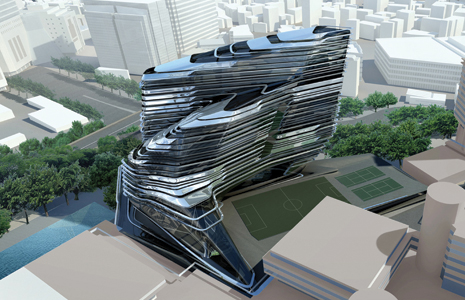
The Hong Kong Polytechnic University (PolyU) has recently received a donation of HK$249 million from The Hong Kong Jockey Club in support of the Innovation Tower, the future home of the University’s renowned School of Design (SD) and the Design Institute for Social Innovation (DISI).
The Innovation Tower is the creation of Ms Zaha Hadid, a world-renowned architect and the first female recipient of the coveted Pritzker Architecture prize. Located at the northeastern tip of the University campus, the Tower is expected to be completed by the end of 2012. Upon completion, the 14-storey Tower will provide some 15,000 square metres of net floor area and all the necessary equipment and facilities for design education and innovation, including auditorium, design museum, gallery and exhibition spaces, multi-functional classrooms and lecture theatres, design studios and workshop spaces. It will provide a unique environment for the future development of SD into one of the leading institutions of its kind in the world.
Besides supporting the learning, teaching and research activities of SD, the Tower will also house the DISI, which aims to become an international design, innovation and entrepreneurship hub where Hong Kong’s higher education institutions can collaborate with the business sector and community groups to bring innovative ideas with social relevance into commercial viability. The Institute will provide an open platform for students and young designers to learn and interact, and to carry out collaborative interdisciplinary design projects which can be applied to the real world.
To address the critical emerging social needs in Hong Kong and the Pearl River Delta Region, the DISI will concentrate on project development and knowledge transfer in four strategic themes – Service Design, Sustainable Environments, Holistic Health, and Adolescent and Family Development, which reflect the core competencies of SD. With all these core activities, it is expected that DISI will become a vibrant learning resource for the design community and a “third space” between the institutions of higher learning and the real world of business, industry and community.




